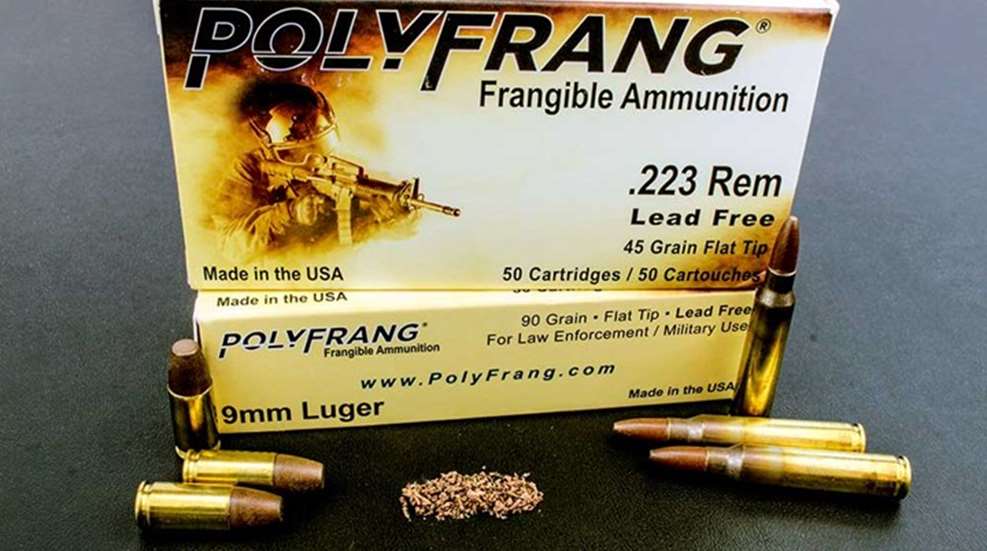
Whereas traditional ammunition most often features a bullet made of solid lead jacketed in copper that holds the bullet together as it penetrates a target, frangible ammo features a bullet that fragments, or in some cases is pulverized, after striking its first significant barrier. Frangible projectiles are used for three main reasons:
1. Frangible bullets penetrate less than non-frangible bullets because after the bullet comes apart, the resulting individual fragments have less weight and therefore less momentum (energy) to drive them through a medium. For example, a frangible bullet may have the initial energy (while whole) to enter a target, but not enough energy to exit it and/or then penetrate a wall nearby. As such, frangible ammo may be preferred for specialized scenarios such as aboard aircraft where a breach in the craft’s walls by a bullet could be catastrophic to everyone. Other tactical uses could be in crowded areas or apartment complexes where bullet passthroughs could be potentially deadly to innocent people in the next room.
2. Because a frangible bullet’s fragments have less energy than the sum of them while whole, they also have less energy available to rebound, or ricochet. In other words, frangible bullets produce less risk of ricochet than traditional bullets. So for people who practice shooting on steel targets--where ricochet is a real concern--or engage in ultra-close-range practice, frangible ammo is an excellent choice.
3. Because the material of choice to make frangible bullets is often a copper alloy, or even powdered copper held together with a metal or polymer binding agent--not lead--frangible ammo is most often non-toxic.
Disadvantages
Frangible ammo is not without its downsides. First, because it doesn’t penetrate well, frangible ammo is not the ammo of choice for most self-defense scenarios that are unpredictable by their very nature. In other words, you likely will not know what a would-be attacker might be wearing in terms of armor or heavy clothing, and so most self-defenses experts opine that it's best to hedge on the side of bullet penetration when your life's on the line. Perhaps an attacker breaks into your home and takes cover behind a couch as he fires a weapon at you. A premium, controlled expansion bullet would likely be capable of penetrating the couch and stopping his attack, while a frangible bullet would likely not.
Secondly, because most frangible bullets are made of copper and/or an alloy, most are substantially lighter than lead bullets, therefore they may not strike to the same point-of-impact (POI) when fired from your firearm. Furthermore, despite their often increased velocities, their lighter weight combined with less recoil energy could make them less reliable in semi-automatic firearms. So it’s best to check for point of aim/point of impact disparities--as well as functionality--in your firearm before purchasing large quantities for practice or before considering them for personal defense.
Basic Types of Frangible Bullets
Over the years there have been several advancements in the frangible ammo category, but most use one of three general designs:
1. Glaser Safety Slug: This proprietary projectile was made by Glaser in 1982 and was later purchased by the Cor-Bon ammo company. The bullet features a thin copper jacket and plastic dome that encapsulates many No. 12 shot pellets held within. The slug and pellets travel down the bore and toward the target as a solid unit, but upon impact the tiny pellets act like a miniature shotgun pattern to cause damage. However, because each individual pellet has very little energy after dispersion, they do not penetrate secondary barriers well. Glaser Safety Slugs are generally reported to work very well in self-defense situations where overpenetration could be hazardous to other people or things. Reports indicate the round has no trouble penetrating common heavy clothing such as leather jackets, denim, etc., and will even penetrate car doors. As a specialized, hard-to-manufacture round, however, they are not cheap and as such not intended as a practice round.
2. Powdered Metal Projectiles: Today the most common type of frangible bullets are made from powdered metal that’s compressed, using a metal or polymer binding agent to hold it together during firing. When it strikes a hard target, however, it literally pulverizes itself so that it’s reduced to small particles or even dust. While some of these bullets are touted for defense and hunting--as they have enough energy to kill the initial target they strike--the majority are intended for practice to reduce the likelihood of dangerous ricochet. Interceptor’s ARX is one example.
3. Segmented Projectile: Some bullet manufacturers offer projectiles that are specially designed to break into several fragments upon first contact. Winchester’s PDX1 Defender Segmenting shotgun slug is a great example. This slug is pre-programmed to split into three large fragments that individually do great damage via three wound channels yet do not penetrate as deep as the slug as a whole would. This slug is also desirable for shooting steel plates at close range during practice due to less ricochet danger.
Frequently Asked Questions:
While there are several internet rumors stating frangible ammo can ruin handgun barrels, I find this unproven and difficult to understand, as nearly all frangible ammo is made of copper and/or metals that are softer than copper; therefore causing swift damage to a steel barrel is unlikely. However, due to some frangible bullets’ soft, powdery nature, some have been reported to foul barrels more than traditional ammo. If this is the case, rest easy because fouling (also called barrel smoothing in extreme cases if the ) can be removed by standard cleaning of the barrel.







































